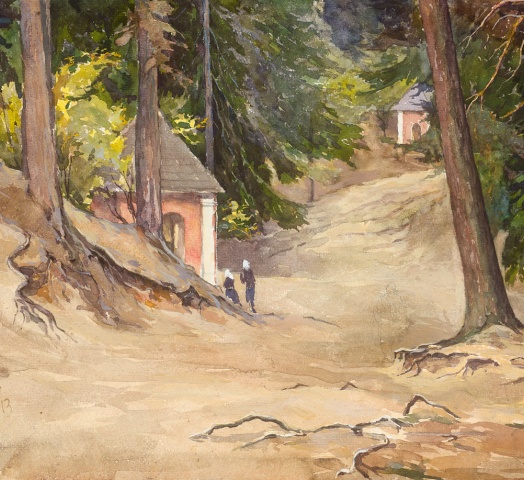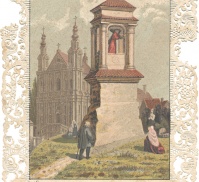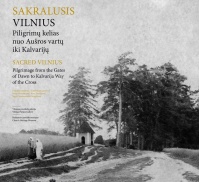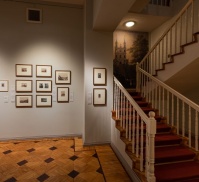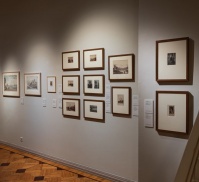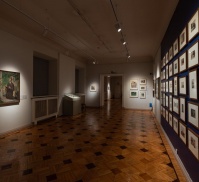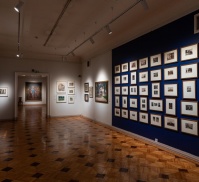Exhibition "Sacred Vilnius"
The Vilnius Picture Gallery and the Church Heritage Museum are opening the exhibition "Sacred Vilnius: Pilgrimage from the Gates of Dawn to Kalvarija Way of the Cross" on 20th of April. It is a part of the exhibition series dedicated to Vilnius by the National Lithuanian Museum.
The exhibition contains three works from our collection: T. Marinowski in Kalvarijos (1944) by Piotr Siergijewicz, Vilnius Calvary (1913) by Sergey Yuzhanin and The roadside shrine in Šnipiškės with the sculpture ‘Christ carrying the cross’ by Unknown artist.
Vilnius is famed as a city of churches and monasteries since olden times, while Catholic architecture is the highlight of its artistic panorama. Of significance is also the theme of the Calvaries of Vilnius, known in Lithuanian as Vilnius Kalvarija. This unique ensemble that emerged in the 17th–18thcenturies on the property of the bishop of Vilnius at Verkiai remained a vibrant site of devotional practice over the course of several centuries. Due to its natural features similar to Jerusalem during Christ’s time, as described by theologians, and its paths, sprinkled, at the consecration solemnity, with soil brought from Jerusalem, the sacred ensemble of the Stations of the Cross was experienced by the pious as a symbolical copy of the Holy Land. It was perceived to have the powers and functions of the original the same way as the holy images. The content of the ensemble became most powerfully manifest by the devotional practice of following the Way of the Cross, with groups of the pious and pilgrims meandering along the paths between the chapels.
This two-part exhibition is hosted by two museums: the display at the Picture Gallery of the Lithuanian National Museum of Art explores the iconographic features of the temples and shrines visited by the pilgrims on their way, while the Church Heritage Museum invites to see different pieces of art connected to these temples and chapels. These two parts are linked by the extant paintings from the chapels of Vilnius Calvary, part of which were thought to have been lost in the wake of the 1963 destruction.
The displays follow the ‘long’ pilgrim route as it emerges from historical sources: the faithful started their way at the Gates of Dawn, stopped at the Chapel of the Holy Stairs next to the Church of St Francis and St Bernardino, then at the Chapel of Christ Carrying the Cross at Šnipiškės, and headed along the road, which with time received the name of Kalvarijų Street. The arrangement of the exhibitions allows to revisit important monuments to Christian identity of Vilnius situated (or already lost) in the centre of the city.
The exhibition of the Church Heritage Museum displays artefacts and liturgical items from the Treasury of the Chapel of the Gates of Dawn, lesser known not only to the general public, but even to researchers of Christian heritage, and the works of art rescued from the chapels of Kalvarija, the Chapel of Šnipiškės and the Chapel of the Holy Stairs that survived into our times.
The memorial function of the Calvaries of Vilnius is also notable: the site created to revisit and contemplate the history of Salvation of the World, commemorates also a concrete episode in the history of Lithuania, the liberation of Vilnius from Muscovy occupation in 1662. The first Stations of the Cross founded in 1664 by Bishop Georgius Białłozor supposedly were marked only by crosses, yet already at the end of the 17th century wooden chapels were started to build. The Church of the Discovery of the Holy Cross was constructed around 1755–1759. In 1772, Bishop Tomasz Ignacy Zienkowicz consecrated a renovated church and twenty new brick chapels. Despite the Russian Tsarist authorities’ restrictions imposed in the 2ndhalf of the 19th century, and the subsequent attempts by the Soviets to destruct the Calvaries (most of the chapels were blown up between 1962 and 1963), the tradition of pilgrimages to the site survived and was reborn after the reestablishment of Lithuania’s statehood. The rebuilt chapels of the Way of the Cross were re-consecrated in 2002.
Exhibition Curators: Rasa Adomaitienė, Rūta Janonienė, Sigita Maslauskaitė-Mažylienė
Exhibition Co-ordinators: Kamilė Jagėlienė, Rita Pauliukevičiūtė, Indraja Kubilytė
Exhibition Designer Saulius Valius
Exhibition Graphic Designer Juozapas Švelnys
Sponsors: Archdiocese of Vilnius, Lithuanian Council for Culture

The Vilnius Picture Gallery and the Church Heritage Museum are opening the exhibition "Sacred Vilnius: Pilgrimage from the Gates of Dawn to Kalvarija Way of the Cross" on 20th of April. It is a part of the exhibition series dedicated to Vilnius by the National Lithuanian Museum.
The exhibition contains three works from our collection: T. Marinowski in Kalvarijos (1944) by Piotr Siergijewicz, Vilnius Calvary (1913) by Sergey Yuzhanin and The roadside shrine in Šnipiškės with the sculpture ‘Christ carrying the cross’ by Unknown artist.
Vilnius is famed as a city of churches and monasteries since olden times, while Catholic architecture is the highlight of its artistic panorama. Of significance is also the theme of the Calvaries of Vilnius, known in Lithuanian as Vilnius Kalvarija. This unique ensemble that emerged in the 17th–18thcenturies on the property of the bishop of Vilnius at Verkiai remained a vibrant site of devotional practice over the course of several centuries. Due to its natural features similar to Jerusalem during Christ’s time, as described by theologians, and its paths, sprinkled, at the consecration solemnity, with soil brought from Jerusalem, the sacred ensemble of the Stations of the Cross was experienced by the pious as a symbolical copy of the Holy Land. It was perceived to have the powers and functions of the original the same way as the holy images. The content of the ensemble became most powerfully manifest by the devotional practice of following the Way of the Cross, with groups of the pious and pilgrims meandering along the paths between the chapels.
This two-part exhibition is hosted by two museums: the display at the Picture Gallery of the Lithuanian National Museum of Art explores the iconographic features of the temples and shrines visited by the pilgrims on their way, while the Church Heritage Museum invites to see different pieces of art connected to these temples and chapels. These two parts are linked by the extant paintings from the chapels of Vilnius Calvary, part of which were thought to have been lost in the wake of the 1963 destruction.
The displays follow the ‘long’ pilgrim route as it emerges from historical sources: the faithful started their way at the Gates of Dawn, stopped at the Chapel of the Holy Stairs next to the Church of St Francis and St Bernardino, then at the Chapel of Christ Carrying the Cross at Šnipiškės, and headed along the road, which with time received the name of Kalvarijų Street. The arrangement of the exhibitions allows to revisit important monuments to Christian identity of Vilnius situated (or already lost) in the centre of the city.
The exhibition of the Church Heritage Museum displays artefacts and liturgical items from the Treasury of the Chapel of the Gates of Dawn, lesser known not only to the general public, but even to researchers of Christian heritage, and the works of art rescued from the chapels of Kalvarija, the Chapel of Šnipiškės and the Chapel of the Holy Stairs that survived into our times.
The memorial function of the Calvaries of Vilnius is also notable: the site created to revisit and contemplate the history of Salvation of the World, commemorates also a concrete episode in the history of Lithuania, the liberation of Vilnius from Muscovy occupation in 1662. The first Stations of the Cross founded in 1664 by Bishop Georgius Białłozor supposedly were marked only by crosses, yet already at the end of the 17th century wooden chapels were started to build. The Church of the Discovery of the Holy Cross was constructed around 1755–1759. In 1772, Bishop Tomasz Ignacy Zienkowicz consecrated a renovated church and twenty new brick chapels. Despite the Russian Tsarist authorities’ restrictions imposed in the 2ndhalf of the 19th century, and the subsequent attempts by the Soviets to destruct the Calvaries (most of the chapels were blown up between 1962 and 1963), the tradition of pilgrimages to the site survived and was reborn after the reestablishment of Lithuania’s statehood. The rebuilt chapels of the Way of the Cross were re-consecrated in 2002.
Exhibition Curators: Rasa Adomaitienė, Rūta Janonienė, Sigita Maslauskaitė-Mažylienė
Exhibition Co-ordinators: Kamilė Jagėlienė, Rita Pauliukevičiūtė, Indraja Kubilytė
Exhibition Designer Saulius Valius
Exhibition Graphic Designer Juozapas Švelnys
Sponsors: Archdiocese of Vilnius, Lithuanian Council for Culture






